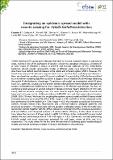Por favor, use este identificador para citar o enlazar a este item:
http://hdl.handle.net/10261/268191COMPARTIR / EXPORTAR:
 SHARE
BASE SHARE
BASE
|
|
| Visualizar otros formatos: MARC | Dublin Core | RDF | ORE | MODS | METS | DIDL | DATACITE | |

| Título: | Integrating an epidemic spread model with remote sensing for Xylella fastidiosa detection |
Autor: | Camino, Carlos CSIC ORCID; Calderón Madrid, Rocío CSIC ORCID CVN; Parnell, Stephen; Dierkes, H.; Chemin, Y.; Román Ecija, Miguel CSIC ORCID; Montes Borrego, Miguel CSIC; Landa, Blanca B. CSIC ORCID ; Navas Cortés, Juan Antonio ; Zarco-Tejada, Pablo J. CSIC ORCID; Beck, P. S. A. | Palabras clave: | Hyperspectral Thermal Xylella fastidiosa Nutritional Spread mode |
Fecha de publicación: | abr-2021 | Citación: | 3rd European Conference on Xylella fastidiosa (2021) | Resumen: | Xylella fastidiosa (Xf) causes plant diseases that lead to massive economic losses in agricultural crops, making it one of the pathogens of greatest concern to agriculture nowadays. Detecting Xf at early stages of infection is crucial to prevent and manage outbreaks of this vector-borne bacterium. Recent remote sensing (RS) studies at different scales have shown that Xf-infected olive trees have distinct spectral features in the visible and infrared regions (VNIR). However, RS-based forecasting of Xf outbreaks requires tools that account for their spatiotemporal dynamics. Here, we show how coupling a spatial Xf-spread model with the probability of Xf-infection predicted by an RS-driven modeling algorithm based on a Support Vector Machine (RS-SVM) helps detecting the spatial Xf distribution in a landscape. To optimize such model, we investigated which RS plant traits (i.e., pigments, structural or leaf protein content) derived from high-resolution hyperspectral imagery and biophysical modelling are most responsive to Xf infection and damage. For that, we combined a field campaign in almond orchards in Alicante province (Spain) affected by Xf (n=1,426 trees), with an airborne campaign over the same area to acquire high-resolution thermal and hyperspectral images in the visible-near-infrared (400-850 nm) and short-wave infrared regions (SWIR, 950-1700 nm). We found that coupling the epidemic spread model and the RS-based model increased accuracy by around 5% (OA = 80%, kappa = 0.48 and AUC = 0.81); compared to the best performing RS-SVM model (OA = 75%; kappa = 0.50) that included as predictors leaf protein content, nitrogen indices (NIs), fluorescence and a thermal indicator, alongside pigments and structural parameters. The parameters with the greatest explanatory power of the RS model were leaf protein content together with NI (28%), followed by chlorophyll (22%), structural parameters (LAI and LIDFa), and chlorophyll indicators of photosynthetic efficiency. In the subset of almond trees where the presence of Xf was tested by qPCR (n=318 tress), the combined RS-spread model yielded the best performance (OA of 71% and kappa = 0.33). Conversely, the best-performing RS-SVM model and visual inspections produced OA and kappa values of 65% and 0.31, respectively. This study shows for the first time the potential of combining spatial epidemiological models and remote sensing to monitor Xf-disease distribution in almond trees. | Descripción: | Trabajo presentado en la 3rd European Conference on Xylella fastidiosa (Building knowledge, protecting plant health), celebrada online el 29 y 30 de abril de 2021. | Versión del editor: | https://doi.org/10.5281/zenodo.4884617 | URI: | http://hdl.handle.net/10261/268191 | DOI: | 10.5281/zenodo.4884617 | Identificadores: | doi: 10.5281/zenodo.4884617 |
| Aparece en las colecciones: | (IAS) Comunicaciones congresos |
Ficheros en este ítem:
| Fichero | Descripción | Tamaño | Formato | |
|---|---|---|---|---|
| Xylella_fastidiosa_detection_presentacion.pdf | 3,74 MB | Adobe PDF |  Visualizar/Abrir | |
| Xylella_fastidiosa_detection_resumen.pdf | 162,64 kB | Adobe PDF |  Visualizar/Abrir |
CORE Recommender
Page view(s)
47
checked on 29-abr-2024
Download(s)
27
checked on 29-abr-2024
Google ScholarTM
Check
Altmetric
Altmetric
Este item está licenciado bajo una Licencia Creative Commons

